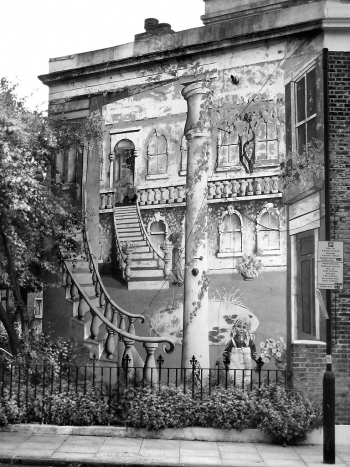He found her on the railway line. Her hair was bright yellow, the colour that children paint sunlight, tied in thick bunches around her small, cold cheeks. She wore a blue shirt, as brilliant as a summer sky. In her left hand, she held a small bunch of daisies. They were vivid in colour, but darkening slowly with age, turning to dust as the heat scorched their petals.
She belonged here. He knew that. He let her go.
This girl remembered a very different world. Streets sitting tightly together, the buildings before the bombs. Her mother’s face before she died, bright, wide and bonny. Her father going away, and him not coming back. But now she was here, and she must make her own way. By the grove of Queen Margaret, along the walk of King Henry, near Cowper and Spenser and Milton and Shakespeare. That was us. This is me. This is how it must be.
She found her on Newington Green. Her eyes were wide, a shade of soft bluebells. The bench that held her caressed her limbs gently. She was wearing pale yellow dungarees, a little faded now, once as shiny as a sou’wester. On her feet, two greying shoes without dents from her toes. One arm stretching out towards the green, clipped grass, her fingers extended as if she was longing to touch it, to take in its brightness. In the other hand, five stems, all washed out.
This was something different. She knew that. She kissed her, walked on.
This girl remembered the huge, old house. The nine windows, the staircases, the long, lovely banisters. Her mother’s pea-green back fading through the second door; the shadow of her father standing beneath her, his brown cap, amber waistcoat, old legs wrapped in grey wool. The blue worlds behind both of them, the treasures beyond the walls. After them, she took her time to play in those shadows, smile her way through the rooms. Still, she was lonely here. She longed for everything else.
The boy found her by the church of St Jude. Her skin was sallow, her throat light and white. Her bones were so little, like tough, tiny weeds. She looked like a pale watercolour, fading into the gravestones. The memories of blooms lying on the ground next to her. Once she was fair, and now hardly there.
She was everywhere, always. He knew her. He always had.
This girl remembered the pillar, lifting up to the clouds. One day she had climbed it, pushing her little limbs upwards. She climbed and she climbed and, at the top, there was nothing. There was only the city before her, the thing she had longed for, the thing she had yearned for, the thing that she loved.
She stood on the top. She let her flowers fall. She had won. She was done.
The girl found May on the side of a building on Wolsey Road. She was no more than six. She stood at the bottom-right-hand corner of a painting, garlanded with balconies, plants, leaves and flowers. The scene was older now, faded, the colours weakening in the daylight, so much so that it was hard to see the man and woman behind her. A crack ran through the middle of it, scarring the concrete, but May still drew the eye. She made you think this was a picture you could walk into, be part of, lose yourself inside.
The girl wondered what had been here before and, as she looked outside the house, she took in the old spirit of Mildmay, the council estates rising from the war damage, the buildings filled in, the stories unspoken. Opposite, the schoolchildren flooded out of the gates, leaving behind the black bars, the grey tarmac. Their voices rose like silver bells. May’s smile glistened, came alive.


